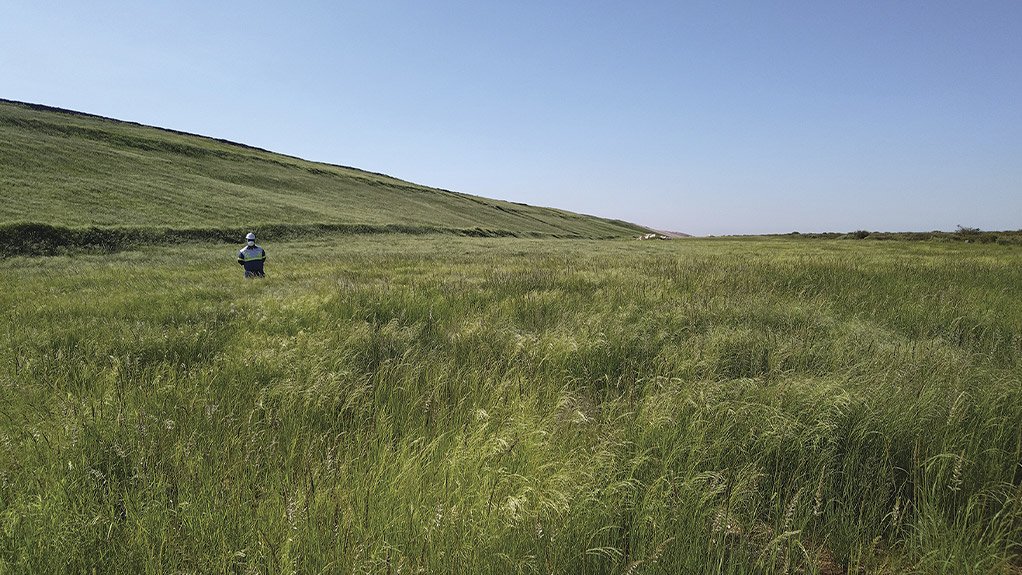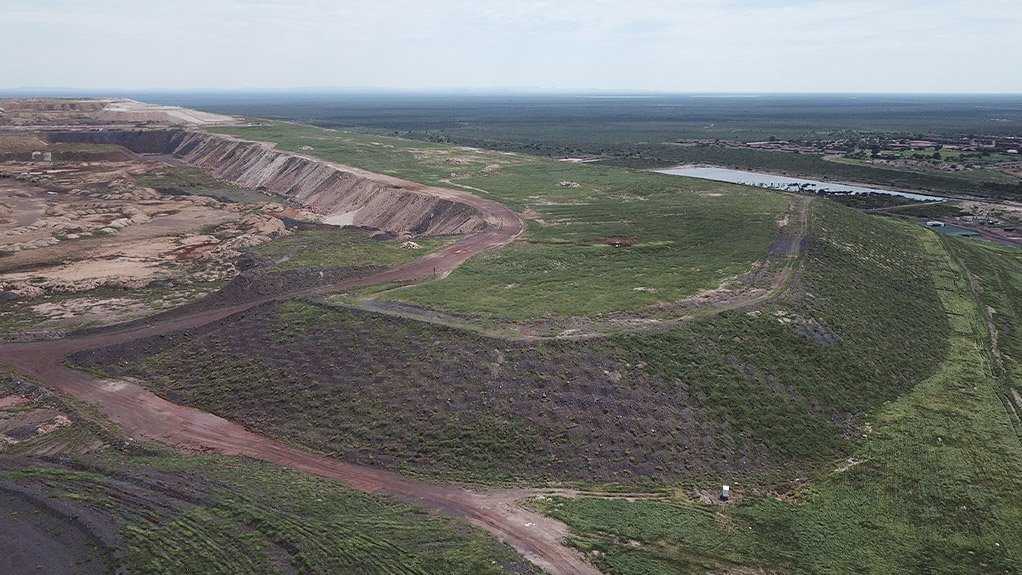Kumba stresses benefit of concurrent rehabilitation
Iron-ore producer and Anglo American subsidiary Kumba Iron Ore is implementing concurrent rehabilitation and closure measures at the company’s flagship open pit Sishen operation, near the town of Kathu, in the Northern Cape. The operation has a 16 year life-of-mine to 2039.
The rehabilitation activities at Sishen are aimed at achieving several objectives such as keeping the mine’s disturbance footprint to a minimum, rehabilitating disturbed areas that will be sustainable after mine closure.
They also include the removal of the topsoil before mining and storing it for later use during the rehabilitation of waste-rock dumps, revegetating disturbed areas with indigenous plant species, and establishing projects that can create long-term community benefits.
Kumba Iron Ore land management technician Dawid Malo states that work to support rehabilitation at Sishen has been ongoing for decades – as studies on rehabilitation at Sishen began in about 1985 and a trust to fund rehabilitation activities was initiated in 1991.
In 2017 the miner began implementing concurrent rehabilitation activities.
“This involved conducting rehabilitation on mine-impacted areas as they occurred. As the company has grown and more information has been gathered based on mine-closure standards, strategies and guidelines, we have all the necessary documentation and information needed for standardisation from parent company Anglo American.”
Mine waste dumps are an environmental liability and, consequently, Kumba has marked the rehabilitation of these waste dumps as a priority, he says.
“We have a large backlog of work that needs to be done, and we’ve had to identify particular waste-rock dump deposits to rehabilitate during the life-of-mine, so that when we have to close the mine, we don’t have to spend as much money. We’ve rehabilitated about 406 ha between 2003 and 2009.”
Sustainable Rehabilitation
Malo states that the current end-land use for the waste-rock dumps is to rehabilitate these areas so that they can support small-scale activities such as grazing.
For this, Kumba needed to select specific grass species and seed mixes that can deliver a yield to sustain grazing practices.
The company is also investigating other end-land uses, and is conducting studies to repurpose certain areas for other purposes.
This could include demolishing a car park area to use for other purposes, such as grazing land, or possibly a refurbishing workshop, which the local community can use.
These studies will also consider the socioeconomic benefits of repurposing these areas for the host communities after mine closure.
Topsoil, Dust Reduction
Malo reaffirms that Kumba Iron Ore has implemented measures to mitigate a lack of topsoil, as the miner has prioritised the stripping of topsoil before any infrastructure development begins.
Plans for infrastructure development must be presented to the company’s environmental department to examine which vegetation occurs and how to protect these species.
“When we strip the topsoil, generally, there is important plant species we need to protect, but where there is not, we approve clearance of the topsoil area. Owing to the lack of topsoil at Sishen, we tend to blend the topsoil with the subsoil so that we have enough soil to rehabilitate areas.”
Mining activities also generally result in excessive dust generation, especially for host communities, but the miner’s completion of rehabilitation and revegetation at the waste dump has resulted in less dust affecting host communities.
“In the event that there are activities on the dump, owing to rehabilitation activities, the area is irrigated to be dust-suppressed. This was vital to ensure that we prioritise areas that are exposed to side effects from mining activities”.
Economic, Environmental Projects
In terms of establishing projects meant to socially and economically support the host communities of the mine, Malo states that Kumba is examining the prospect of establishing solar photovoltaic facilities on the mines’ waste dumps.
For example, the miner is working towards establishing a solar farm for the waste dump, for which a feasibility study has been completed. Construction is expected to begin towards the end of this year.
Kumba has also been conducting studies on establishing agricultural production activities on what was previously the waste-rock dumps.
This includes a trial for pecan nuts, established on the dump, which entails planting about one-hundred trees, as the dump site is large enough to support the solar farm and the agricultural activities. Stormwater captured during the dewatering process in mining is used to irrigate the trees until their root system is established.
An on-site nursery has also been established at Sishen mine, which is used to cultivate indigenous trees and shrubs.
Malo states that this benefitted rehabilitation activities at the mine, as Kumba did not have to buy trees meant for rehabilitation and closure activities.
There are about 15 000 indigenous trees in the mines’ nursery.
After closure, this nursery can be used to benefit the local community and boost economic activity in the area, Malo concludes.
Article Enquiry
Email Article
Save Article
Feedback
To advertise email advertising@creamermedia.co.za or click here
Press Office
Announcements
What's On
Subscribe to improve your user experience...
Option 1 (equivalent of R125 a month):
Receive a weekly copy of Creamer Media's Engineering News & Mining Weekly magazine
(print copy for those in South Africa and e-magazine for those outside of South Africa)
Receive daily email newsletters
Access to full search results
Access archive of magazine back copies
Access to Projects in Progress
Access to ONE Research Report of your choice in PDF format
Option 2 (equivalent of R375 a month):
All benefits from Option 1
PLUS
Access to Creamer Media's Research Channel Africa for ALL Research Reports, in PDF format, on various industrial and mining sectors
including Electricity; Water; Energy Transition; Hydrogen; Roads, Rail and Ports; Coal; Gold; Platinum; Battery Metals; etc.
Already a subscriber?
Forgotten your password?
Receive weekly copy of Creamer Media's Engineering News & Mining Weekly magazine (print copy for those in South Africa and e-magazine for those outside of South Africa)
➕
Recieve daily email newsletters
➕
Access to full search results
➕
Access archive of magazine back copies
➕
Access to Projects in Progress
➕
Access to ONE Research Report of your choice in PDF format
RESEARCH CHANNEL AFRICA
R4500 (equivalent of R375 a month)
SUBSCRIBEAll benefits from Option 1
➕
Access to Creamer Media's Research Channel Africa for ALL Research Reports on various industrial and mining sectors, in PDF format, including on:
Electricity
➕
Water
➕
Energy Transition
➕
Hydrogen
➕
Roads, Rail and Ports
➕
Coal
➕
Gold
➕
Platinum
➕
Battery Metals
➕
etc.
Receive all benefits from Option 1 or Option 2 delivered to numerous people at your company
➕
Multiple User names and Passwords for simultaneous log-ins
➕
Intranet integration access to all in your organisation



















